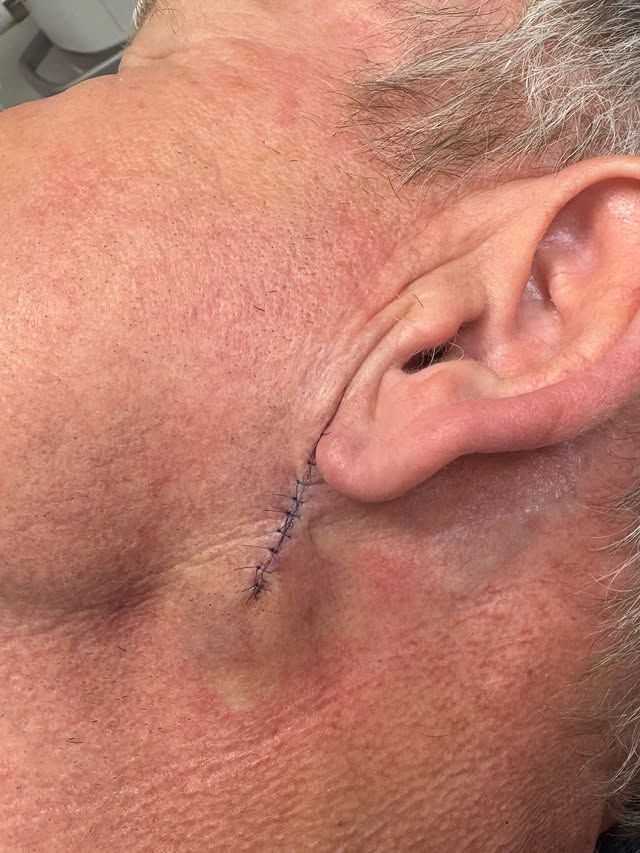
When celebrity chef and restauranteur, Gordon Ramsay, revealed that he had been treated for basal cell carcinoma (BCC), the news quickly went viral, serving as a global PSA about the dangers of skin cancer.
On August 30, 2025, Ramsay announced his BCC diagnosis and treatment in an Instagram post. He shared two photos: One showing one side of his face bandaged under his left ear; another with a close-up of the stitches on his jawline below the ear. Ramsay praised his medical team for quick action, while instructing fans to protect their skin from the sun.
“Please Don’t Forget Your Sunscreen.”

Photo credit: @gordongram on Instagram.
With a touch of his trademark humor, Ramsay urged followers: “Please don’t forget your sunscreen this weekend ❤️ I promise you it’s not a face lift! I’d need a refund. ”
In a short matter of time, Ramsay’s news spread around the world. Media outlets led the charge; their stories about the chef’s skin cancer reached an audience of billions. The news drove online searches, as people sought to learn more about basal cell carcinoma. Many searchers visited SkinCancer.org where we saw more than double the traffic to our BCC educational content. On social media, our post about Ramsay’s skin cancer quickly became our most popular content ever , with one million views across Instagram and Facebook.
Why Ramsay’s Announcement Matters
Chef Ramsay’s message was brief, yet powerfully resonant. With just two photos and a few sentences, he conveyed that protecting your skin from the sun helps prevent skin cancer and the surgical scars that may happen as a result.
When celebrities like Ramsay share their stories, they make a difference in the fight against skin cancer in several ways:
- Spreading awareness on a large scale: High‐profile people have large audiences. Their social posts about skin cancer can raise public awareness significantly and make the danger more relatable.
- Reinforcing that sun safety is not optional: Chefs like Ramsay and others who work indoors can still get sun damage that leads to skin cancer.
- Educating that early detection is crucial: Ramsay’s decision to have his skin cancer removed quickly is important. BCCs that are detected and treated early are often highly curable.
- Urging fans to take skin cancer prevention seriously: Ramsay’s message about using sunscreen is vital, because when celebrities use their platforms to influence behaviors, their fans listen.
About Basal Cell Carcinoma (BCC)
- What is basal cell carcinoma? BCC is an abnormal growth that arises from basal cells in the outermost layer of skin. BCC is the most common type of skin cancer, with an estimated 3.6 million cases diagnosed in the United States each year.
- What does BCC look like? Common warning signs include an open sore that does not heal, a reddish patch, a shiny bump or nodule that is pearly or clear, pink, red, pigmented or white, a pink growth with a slightly raised, rolled edge and a central indentation, or a scar-like area that is flat white, yellow or waxy in color. View BCC pictures here.
- Where is BCC found? BCC often develops on skin that is exposed to the sun, including the face, ears, neck, scalp, shoulders and back.
- What causes BCC? Most BCCs are caused by the combination of intermittent, intense exposure and cumulative, long-term exposure to UV radiation from the sun.
- How serious is BCC?BCCs can be locally destructive if not found and treated early. Occasionally these cancers can spread. In rare instances, they can be life-threatening.
Protect Yourself from Skin Cancer
| Use broad spectrum sunscreen daily | Choose SPF 30 or higher; apply one ounce (about a shot glass full) to all exposed skin and reapply every two hours, or when sweating or swimming. |
| Seek shade during peak UV hours | Shade helps reduce UV exposure. When possible, take shade breaks when the sun’s rays are strongest, between 10 AM and 4 PM. |
| Wear protective clothing, hats and sunglasses | Choose long sleeves, wide-brimmed hats and UV-blocking sunglasses. If possible, wear UPF 50 clothing. |
| Do not use tanning beds | Never expose your skin to the dangerous UVA rays emitted by tanning beds. |
| Examine your skin monthly | Look at your skin closely from head-to-toe. Check for anything new, changing or unusual. |
| See a dermatologist at least once a year | Get a professional skin check annually (or more often if you have risk factors). |
